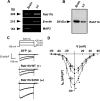Small GTPase Rab11b regulates degradation of surface membrane L-type Cav1.2 channels
- PMID: 21248079
- PMCID: PMC3093944
- DOI: 10.1152/ajpcell.00288.2010
Small GTPase Rab11b regulates degradation of surface membrane L-type Cav1.2 channels
Abstract
L-type Ca(2+) channels (LTCCs) play a critical role in Ca(2+)-dependent signaling processes in a variety of cell types. The number of functional LTCCs at the plasma membrane strongly influences the strength and duration of Ca(2+) signals. Recent studies demonstrated that endosomal trafficking provides a mechanism for dynamic changes in LTCC surface membrane density. The purpose of the current study was to determine whether the small GTPase Rab11b, a known regulator of endosomal recycling, impacts plasmalemmal expression of Ca(v)1.2 LTCCs. Disruption of endogenous Rab11b function with a dominant negative Rab11b S25N mutant led to a significant 64% increase in peak L-type Ba(2+) current (I(Ba,L)) in human embryonic kidney (HEK)293 cells. Short-hairpin RNA (shRNA)-mediated knockdown of Rab11b also significantly increased peak I(Ba,L) by 66% compared when with cells transfected with control shRNA, whereas knockdown of Rab11a did not impact I(Ba,L). Rab11b S25N led to a 1.7-fold increase in plasma membrane density of hemagglutinin epitope-tagged Ca(v)1.2 expressed in HEK293 cells. Cell surface biotinylation experiments demonstrated that Rab11b S25N does not significantly impact anterograde trafficking of LTCCs to the surface membrane but rather slows degradation of plasmalemmal Ca(v)1.2 channels. We further demonstrated Rab11b expression in ventricular myocardium and showed that Rab11b S25N significantly increases peak I(Ba,L) by 98% in neonatal mouse cardiac myocytes. These findings reveal a novel role for Rab11b in limiting, rather than promoting, the plasma membrane expression of Ca(v)1.2 LTCCs in contrast to its effects on other ion channels including human ether-a-go-go-related gene (hERG) K(+) channels and cystic fibrosis transmembrane conductance regulator. This suggests Rab11b differentially regulates the trafficking of distinct cargo and extends our understanding of how endosomal transport impacts the functional expression of LTCCs.
Figures






References
-
- Altier C, Dubel SJ, Barrère C, Jarvis SE, Stotz SC, Spaetgens RL, Scott JD, Cornet V, De Waard M, Zamponi GW, Nargeot J, Bourinet E. Trafficking of L-type calcium channels mediated by the postsynaptic scaffolding protein AKAP79. J Biol Chem 277: 33598–33603, 2002 - PubMed
-
- Anderson CL, Delisle BP, Anson BD, Kilby JA, Will ML, Tester DJ, Gong Q, Zhou Z, Ackerman MJ, January CT. Most LQT2 mutations reduce Kv11.1 (hERG) current by a class 2 (trafficking-deficient) mechanism. Circulation 113: 365–373, 2006 - PubMed
-
- Antzelevitch C, Pollevick GD, Cordeiro JM, Casis O, Sanguinetti MC, Aizawa Y, Guerchicoff A, Pfeiffer R, Oliva A, Wollnik B, Gelber P, Bonaros EP, Jr, Burashnikov E, Wu Y, Sargent JD, Schickel S, Oberheiden R, Bhatia A, Hsu LF, Haïssaguerre M, Schimpf R, Borggrefe M, Wolpert C. Loss-of-function mutations in the cardiac calcium channel underlie a new clinical entity characterized by ST-segment elevation, short QT intervals, and sudden cardiac death. Circulation 115: 442–449, 2007 - PMC - PubMed
-
- Bers DM. Cardiac excitation-contraction coupling. Nature 415: 198–205, 2002 - PubMed
Publication types
MeSH terms
Substances
Grants and funding
LinkOut - more resources
Full Text Sources
Molecular Biology Databases
Miscellaneous

